Around 2pm we reluctantly left La Roche Bernard and made our way towards St. Nazaire, Brittany's main naval base, and Nantes, the region's capital, both on the estuary of France's longest river, the Loire. We decided we'd better make a little progress with our travels rather than visit Nantes so skirted the city to the north travelling along departmental roads through little old villages and a green sunny countryside, filled with the bright fresh colours of spring. Soon we approached the old walled town of Ancenis where we crossed the Loire. Immediately the landscape changed. The stern granite buildings of Brittany gave way to the creamy limestone of the Loire Valley and fields of vegetables were replaced by vineyards. Yes, we have moved sufficiently far south again to find the vines that were so much a part of our lives last autumn and winter. Here in the Loire there is not such a monoculture though as we experienced in the Languedoc with many orchards of fruit trees on the point of blossoming.
We first encountered the Loire back in the Cevennes in October when we took Modestine along the trail followed by Robert Louis Stevenson with his Modestine. Then the Loire was simply an exuberant, bubbling stream. Here it has matured and broadened out into a huge wide sheet of water covering many of the sandy, tree-covered islands lying in its broad channel. The road runs beside the river, beneath the tall white limestone cliff, honeycombed with caves, many used as cellars for the wine producers, others for the cultivation of mushrooms. Many too have been converted into troglodyte dwellings, the front often appearing as a normal house, the back hidden deep within the cliff. Many farms along the banks of the river are selling asparagus for which the region is famous.
 The Loire near St. Florent-le-Viel
The Loire near St. Florent-le-Viel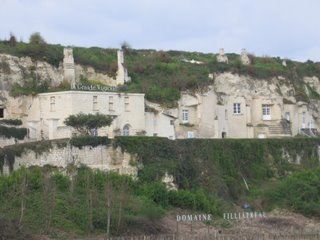 Troglodyte dwellings in the cliffs beside the Loire
Troglodyte dwellings in the cliffs beside the LoireWe paused at St. Florent-le-Viel but found it disappointing with a very ugly church. Stopping to admire a view from the road we discovered a little village known as La Haie Longue. Here in 1908 the two Gasnier brothers, pioneer aviators, made one of the first manned flights in France and there is a monument to commemorate this. They are both buried here in a little chapel. Although one died in his thirties, the other appears to have lived to ninety five. We calculated he would have seen the first manned space flight to land on the moon! He also founded the airport at nearby Angers.
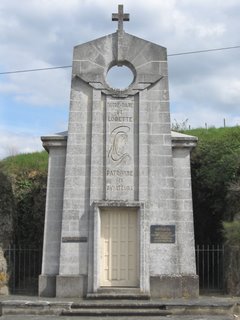 Chapel containing the remains of the Gasnier brothers, La Haie Longue, Loire
Chapel containing the remains of the Gasnier brothers, La Haie Longue, LoireWe passed through Saumur which we have not visited for over ten years. Last time we made the mistake of buying some wine wholesale from a producer who was less than honest, selling us a completely different wine from the one we had tasted and selected! We have naively kept it for years hoping it will mature but just before we left for our travels we tipped it all down the sink in Exeter.
As we continued along the near deserted road beside the Loire, we turned off to investigate an 11th century chapel set in vineyards on the plateau above the river. From here we had a wide view down onto the river. The sun was setting behind us, birds were singing in the hedgerows and everywhere was calm and peaceful.
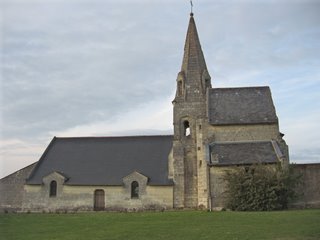 11th century chapel, Parnay-sur-Loire
11th century chapel, Parnay-sur-LoireFriday 21th April 2006, Loches, Loire-et-Indre
So we spent the night there at Parnay-sur-Loire! Supper and wine outside of Modestine on a warm sunny evening, the old stone walls of the church and the leafless vines for company. During the night we heard owls hooting but otherwise slept peacefully. It was a very pleasant experience.
This morning we drove down from our plateau to the valley floor, parking near the river. While Jill boiled water for tea, Ian went off to investigate the village bakers returning with a couple of croissants and an Easter sweetie, a present from the baker! Over breakfast we debated where to go next. It's such a strange sensation being able to do exactly as we please but actually it becomes quite difficult. There are so many places yet to see but all around are places we already know and want to see again. We cannot pass through the Loire without visiting at least one of it châteaux however so decided on Villandry, famed for its wonderful geometric vegetable gardens in the French style. Our way took us past the gates of Ussé on the river Indre. This is the stuff of fairy tales with high round white towers and tall black slated turrets. Indeed it markets itself as the château de la Belle au Bois Dormant, the home of Sleeping Beauty. Inside there are tableaux from the fairy tales of Charles Perrault including Puss in Boots.
 Chateau Montsoreau on the Loire
Chateau Montsoreau on the Loire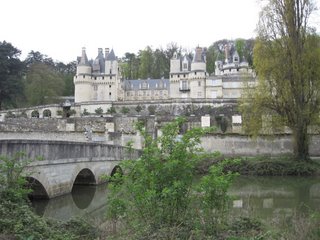 Chateau Ussé on the river Indre
Chateau Ussé on the river IndreWe spent best part of the day at Villandry, visiting both the house and the gardens. Unfortunately we did not see the gardens at their best so early in the season but they were most impressive none-the-less. Normally the formal beds would be planted up with cabbages, carrots, leeks and assorted herbs, the colours complementing each other to give a vibrant display. The paths are all raked gravel between borders of box hedges and beds of bright flowers. There are 52 kilometres of box hedges and 250, 000 flowers and vegetables are planted out annually. It takes four men four months to prune the 1,260 lime trees that shade the walkways in summer. From the top of the castle tower there is a a splendid view across the whole garden. The château was purchased in 1906 By Joachim Carvallo, a Spaniard, to house his collection of mainly 17th century Spanish art. The formal gardens have been developed since this time and the house is still owned by the Carvallo family.
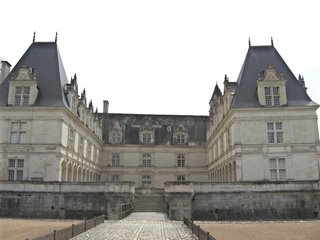 The chateau at Villandry, on the Loire
The chateau at Villandry, on the Loire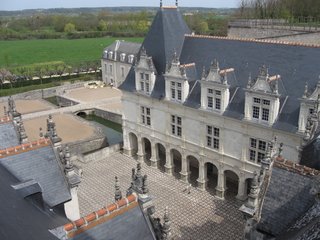 The chateau courtyard at Villandry, on the Loire
The chateau courtyard at Villandry, on the Loire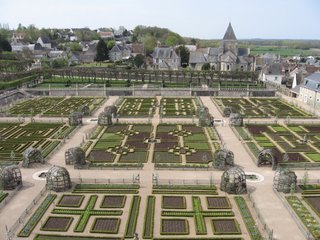 The vegetable gardens at Villandry, on the Loire
The vegetable gardens at Villandry, on the Loire The gardens at Villandry, on the Loire
The gardens at Villandry, on the Loire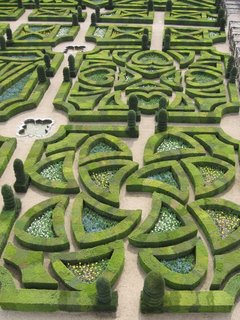 Formal gardens at Villandry, on the Loire
Formal gardens at Villandry, on the Loire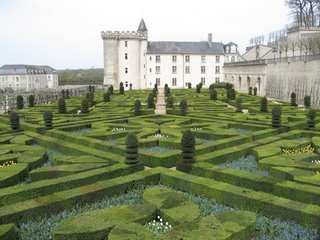 Gardens and chateau of Villandry, on the Loire
Gardens and chateau of Villandry, on the Loire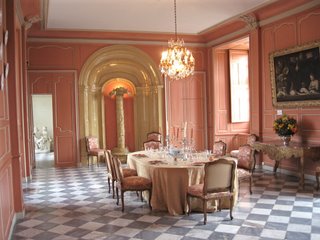 The dining room at Villandry, on the Loire
The dining room at Villandry, on the Loire The kitchen at Villandry, on the Loire
The kitchen at Villandry, on the LoireDuring the afternoon the sun became really hot. There has been no transition between the seasons. Over the past two or three days we have been plummeted from winter into summer. This area is listed as a World Heritage site. Lying as a flat valley plain crossed by the rivers Loire, Vienne, Indre and Cher we are seeing it as it plunges headlong into summer. The trees seem to become greener as we watch them. The two or three swallows we saw a week ago have now become hundreds, skimming and wheeling over the surface of the river. Bats fly during the evening and the hedges are filled with birdsong, hawthorn blossom and spring flowers.
We are heading vaguely towards the Auvergne and Clermont Ferrand. Our route crosses the one we took north to Caen six weeks ago as we returned briefly to Exeter. Indeed, our campsite tonight is at Loches where Modestine was recognised as we made our way north, by friends we had made during our stay at Ambre-les-Espagnolettes last winter. Then, Susan and Ray took us in, dried us out and offered us a bed for the night. At the time they had been about to move into their new home in a nearby village. Passing so near today we decided to call on them to see how they were settling. They were rather surprised when we turned up in their garden pleading for a cup of tea but seemed pleased we'd called, showing us over their house and huge garden. The village is quite delightful and quintessentially French. We are confident they will settle happily into their new surroundings.
Saturday 22nd April 2006, Néris-les-Bains, Allier, Auvergne
Some bird enthusiasts will go to almost any lengths to hear the sound of a nightingale singing its heart out in the dead of night. We have never heard one and not being inclined to forgo a night's sleep to stand hopefully in a damp field, we never expected to hear anything more than a BBC recording. Pesky nightingale! 1am and there it was trilling and warbling away on the branch above Modestine simply for the malicious joy of keeping us awake! Eventually it either gave up or we drifted off to sleep anyway as the next we knew was a crescendo of sound as the massed choirs of the avian population burst forth with a stunning rendition of the Dawn Chorus! Rural France can be a jolly noisy place!
This morning we packed up our still soaking washing and left Loches, which we have visited previously, and travelled to Châteauroux. Here, after much difficulty, we found an internet shop. We also found some cheap lunch and some expensive diesel – fuel prices having risen considerably all of a sudden. A stroll around the town showed it to be quite large with some pleasant streets of old houses. We were disappointed to discover the castle is not red, nor is it accessible to the public, being used as the main law courts for the Indre region. It has connections with Richard the Lion Heart and his brother Bad King John, but its history was too complex for us to unravel without more time and effort than we had available.
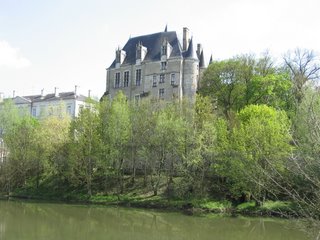 The Castle at Châteauroux
The Castle at ChâteaurouxOur route continued through La Châtre which has very obvious links with the writer George Sand with restaurants named after her novels – La Petite Fadette for example, and even the campsite was called Camping George Sand! There is a Route des Romantiques through the surrounding countryside set up for devotees of her works. Personally, having read "A Winter in Majorca" which she passed with the composer Fredéric Chopin, we did not find her a very likeable character. Her attitude to the Majorcan peasants was distasteful and she appeared rather arrogant. She was certainly a rather bizarre character for her time.
Having driven from Loches during the heat of the day – it really has been hot – we were feeling very weary by the time we passed through Montluçon, a rather large sprawling place where we recalled stopping at a cheap hotel some years ago. The hotel turned out to have messy facilities with a sign in the loo stating that la propreté est la responsibilité de tous (cleanliness is the responsibility of everyone). Ian took great delight in adding "sauf la gestion" (except the management) beneath in red felt-tip!
We arrived at the little spa town of Néris-les-Bains around 7pm to discover the municipal campsite, created on the site of the old railway station with a country walk along the disused track and over the high viaduct. To our delight it has designated one of the sidings in the old goods yard as a special reserve for camping cars. Its aim is presumably to keep these huge vehicles from clogging the little streets of the town during the summer months. To encourage them to use the site there is a spotless loo and a hot shower, all for free! It is attached to the campsite and after two nights vehicles must either leave or pay to use the main site. This is perfect for us and the five other vehicles using the free facility and we have enjoyed supper outside on our own pitch, defined by a neat privet hedge. The sun remained warm and bright until nearly 9pm.
The 19th century station, once a splendid point of arrival to take the waters, is built from pretty pink metamorphosed limestone and has a glaze-tiled roof. It is a very attractive building that has been reincarnated as a superb centre for campers and hostellers in a very lovely setting. The rest of the town we will explore tomorrow.
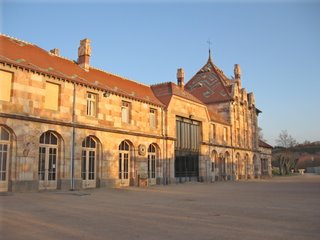 The old station, Néris-les-Bains
The old station, Néris-les-BainsSunday 23rd April 2006, Royat, Puy de Dôme, Auvergne
We are now well into the Auvergne region, its acned landscape pockmarked by the eruption of countless volcanoes during the Earth's adolescence.
We were up early for a change. 8am saw us exploring the bright sunny streets of this bright sunny little town. It is a complete delight, small enough not to have decayed once the 19th century heyday of spa towns had passed. It has very much the atmosphere of a place like Llandridnod Wells with large, attractive houses set in mature grounds, a theatre, casino and of course the thermes or baths. All are still in active use and this must still be a very lively resort during the high season. There are beautiful public gardens where flowering magnolia trees and beds of pansies echo each other in identical shades of white, pink and mauve. Today curists taking the waters can stroll through these gardens, quintessentially those of a 19th century watering place, just as those of an earlier age have done before them.
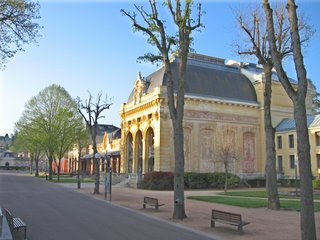 Theatre and casino, Néris-les-Bains
Theatre and casino, Néris-les-Bains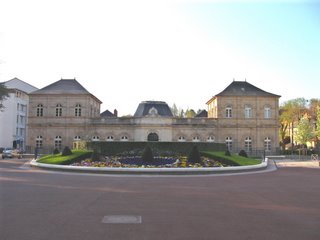 The Thermes, Néris-les-Bains
The Thermes, Néris-les-BainsWe bought croissants at the bakers before settling on the sunny terrace of the Hôtel Leopold et Albert 1er, right near to the main entrance to the thermes. We ordered coffees and enjoyed a very pleasant breakfast watching the curists staying at the hotel stagger off to the baths and come skipping back, presumably cured! Nobody seems bothered if you bring your own croissants with you in France and it's much cheaper!
As so often happens, we would have loved to stay longer but Italy is still beckoning. So mid-morning we left Néris moving slowly south, deep into the Auvergne area. By sheer coincidence, the novel Mont-Oriol by Guy de Maupassant, which we bought at the mediaeval market in Pont Croix in Brittany last week is closely set in this area and provided us with a definite focus for our day. We stopped for lunch at Châtelguyon, the central location for the novel. This is another, larger spa town where the waters of thirteen hot springs supply the two thermal establishments. The analysis of the waters shows it to have the highest magnesium content in Europe as well as an arm's length of additional minerals. The sides of the river running through the town are coated in calcified deposits in bright shades of yellow, red and green. A stray autumn leaf we picked up has become a solidified mass of corroded calcite! There are fountains around the town, caked with mineral deposits that appear most unwholesome. Doctors send patients here for cures, particularly for gynaecological and digestive problems. Maupassant's novel was based on charlatan practices by the medical profession here in the 19th century. As the prosperity of the town was entirely reliant on its thermal waters, there are dozens of impressive hotels to accommodate curists but little else of interest in the town which now shows obvious signs of decline. We did not like it nearly as much as Néris.
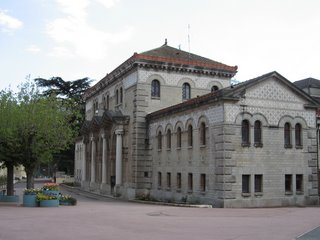 The spa building, Châtelguyon
The spa building, Châtelguyon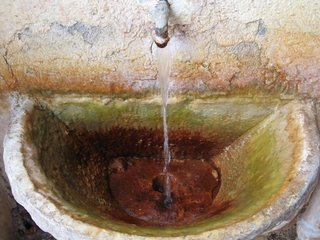 Anyone fancy a drink of hot water? Châtelguyon
Anyone fancy a drink of hot water? Châtelguyon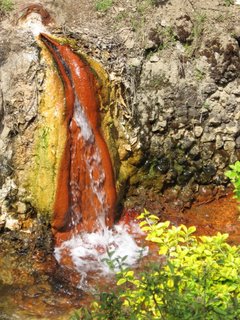 One of the hot sources feeding the stream, Châtelguyon
One of the hot sources feeding the stream, Châtelguyon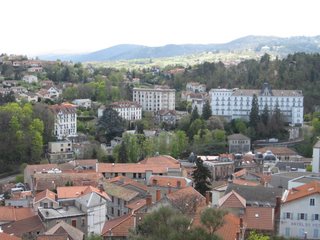 View over Châtelguyon
View over ChâtelguyonNearby lies the crater lake of Gour de Tazenat, completely circular and some 228 feet deep. Unsupervised bathing is permitted but we found the thought rather scary! Needing some exercise we followed the 7km footpath around the rim, sometimes passing through woodland, sometimes with vistas to the distant Puy de Dôme, the highest volcano in the Monts Dômes chain and the one from which the region takes its name. The walk offered us butterflies, the sound of birdsong and the call of the cuckoo, hedgerows of hawthorn blossom, woodlands carpeted with anenomies and celandines, and meadows where the yellow of the dandelions almost hid the green of the grass. Lizards basked in the sun and a snake slithered from the path ahead of us to disappear into the brambles as Ian struggled to open his camera.
 Gour de Tazenat, Auvergne
Gour de Tazenat, Auvergne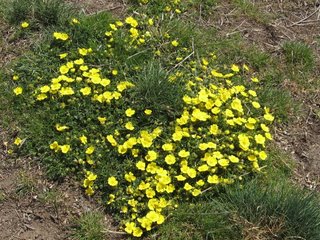 Tourmental at the Gour de Tazenat, Auvergne
Tourmental at the Gour de Tazenat, Auvergne Hawthorn blossom at the Gour de Tazenat, Auvergne
Hawthorn blossom at the Gour de Tazenat, Auvergne Dandelion meadow near Gour de Tazenat, Auvergne
Dandelion meadow near Gour de Tazenat, AuvergneEventually we reached our intended destination of Volvic, famed for the purity of its water which can be found on supermarket shelves throughout Europe where it sells for a small fortune. Here the street fountains run with the stuff and the local population bathe in it.
Volvic is also famous for the quality of it black volcanic stone which has been used for many of the buildings in the town. The nearby city of Clermont Ferrand is built from this dark forbidding stone. In the winter it must seem a dull and overpowering place. Today though, the little town of Volvic looked very pleasant as we explored its darkly cobbled streets, black fountains and churches and even its cemetery where every headstone is carved in the same volcanic stone. It is hard, durable and has a very fine texture which makes it perfect for carving, lettering and even enamelling.
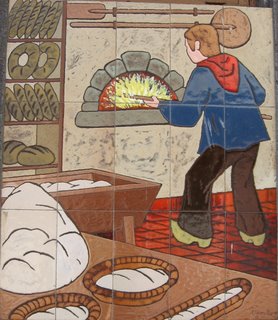 Enamelled plaques made from local stone, Volvic
Enamelled plaques made from local stone, Volvic The church, Volvic
The church, Volvic The cemetery, Volvic
The cemetery, VolvicWe left Modestine near the Source of the stream that feeds the bottling plant above the town and walked up the long path to the castle at Tournoël, constructed high on a promontory of volcanic lava overlooking the town far below. From here we followed a track through woodland, past the huge statue of Notre Dame de la Garde that stands sentinel over the town, to rejoin Modestine. We filled our water bottles at the source and set off to find a campsite but being quite unable to find one in Volvic we continued to Royat, yet another spa town. Here we have found a pleasant if expensive site high above the town. So far we have not had the opportunity of exploring the spa though we remember passing through some years ago when we first discovered this region.
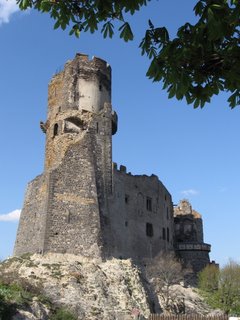 Château Tournoël, Volvic
Château Tournoël, Volvic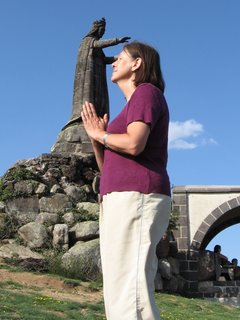 Notre Dame de la Garde bestowing a blessing, Volvic
Notre Dame de la Garde bestowing a blessing, Volvic The source of Volvic mineral water
The source of Volvic mineral water The quarry that formerly supplied the black andesite stone at Volvic
The quarry that formerly supplied the black andesite stone at Volvic